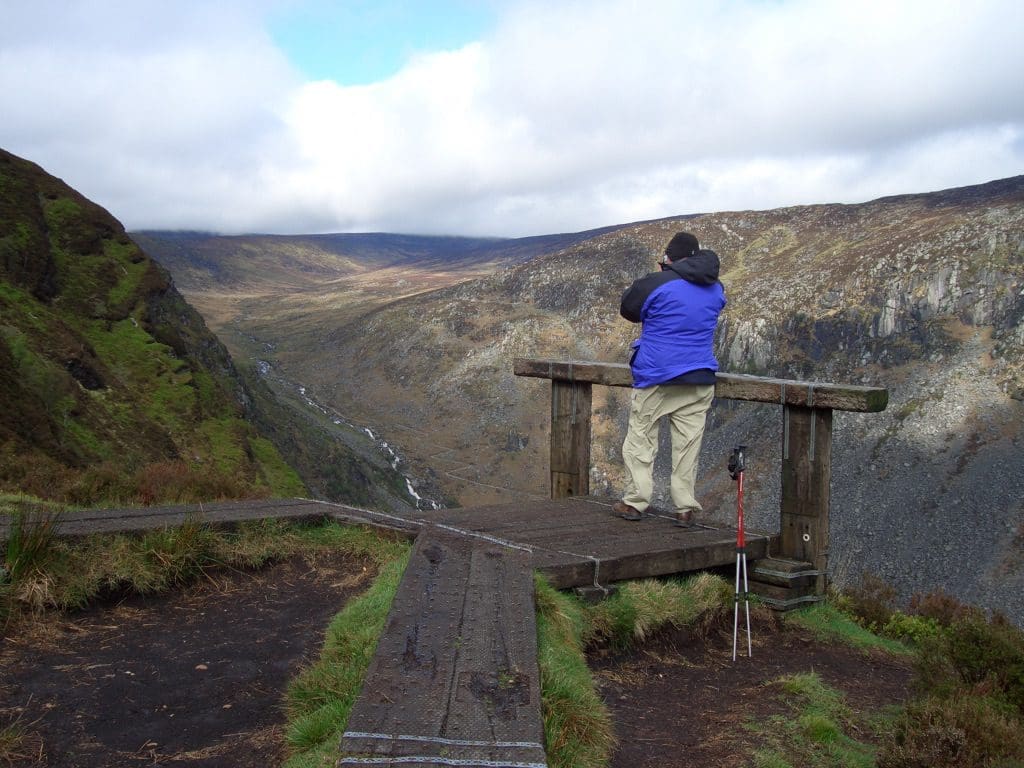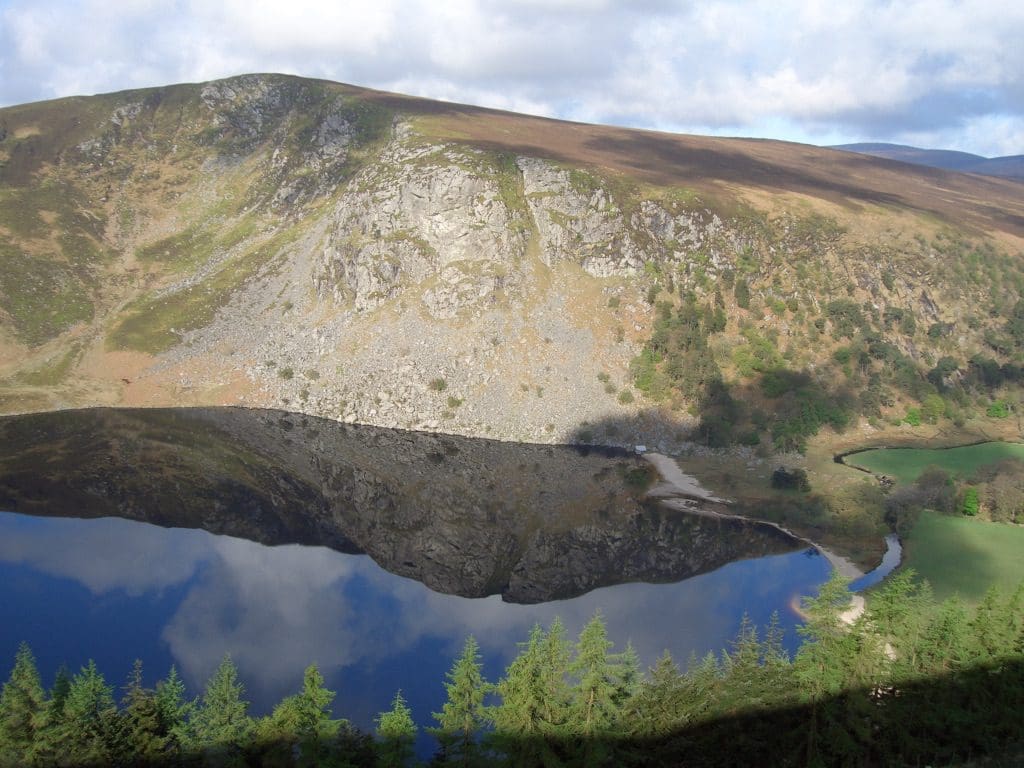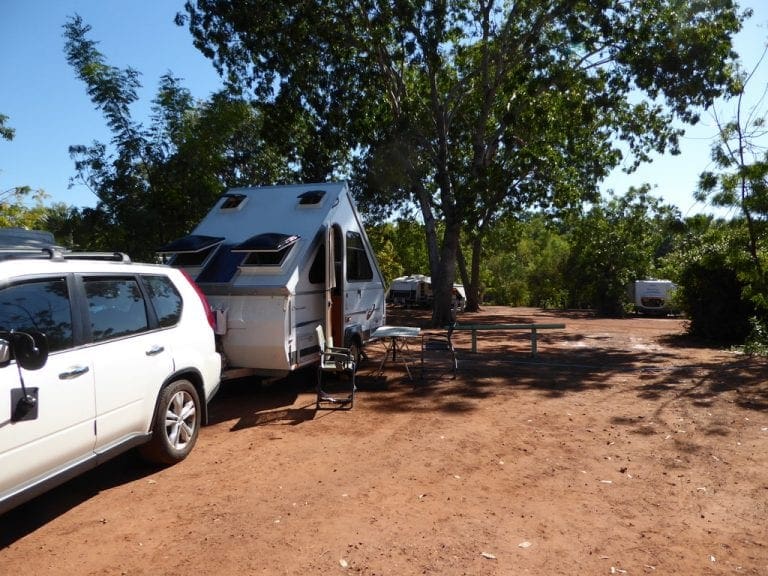Wicklow, Dublin, Newgrange
24/4 drove from Carlow over Wicklow Gap to Glendalough – very famous Irish site founded by a hermit monk St Kevin in 5xx. It became a major religious centre for until 16th century. Now a set of ruins surrounded by tour buses and covered in screaming school children. The monastery grounds have been and still are a very popular place to be buried – hundreds of gravestones – some recent most illegible. We went for a gentle walk around the lower of the two lakes. A very beautiful setting. Kevin might not have welcomed the intrusion.
25/4 a very early start. There is a group of Zoology students from Trinity College here on a field trip. They have a few nets up catching birds. So, Geoff had to get up at 5:30 to join in. It is over 20 years since he handed in his banding licence but it was surprising how much of it came back. Catching 20,000 odd birds over a few years must have left some skills. Very few birds caught here today – too windy. It is great to see that the field trip is still happening (it is actually only 10 years old). We understand that geology field trips in Oz Universities have all but ceased. Geologists there graduate without ever seeing a rock in the wild. At least these kids are having a chance to do a little field work – getting up early, planning a project and carrying it out, contending with weather and working outdoors. [They all pronounce it zoo-ology, but so does almost everyone now. Wonder what happened to zo-ology.)
And speaking of windy. We went on a longish walk up the glen. It wound its way up beside a beautiful waterfall. Then the steps began – 800 steps made out recycled railway sleepers. The first part was sheltered in trees. Then we came out above the trees into a wind swept area that went for 5 km. One of the windiest walks we have done. Very glad to have thermals, vests and raincoats. A very beautiful walk. It drizzled on the way up the mountain and although neither of us said anything the pace slowed – turning back was imminent. Fortunately the drizzle only lasted about 10 minutes and the sun did its best to shine intermittently between the clouds for the rest of the day. There are deer in the valley, however all the deer we saw turned out to be rocks – not much life in them. There used to be an Irish elk which is now extinct – a large animal rather like a moose with a huge set of flat antlers. We solved the riddle of why they are extinct today. The males with their huge antlers tried to walk in the valley above Glendalough – the wind caught their antlers and blew every last one of them over the cliff into the lake. We came back via a path from where we could see Kevin’s cave. Helen says ‘he must have been mad’. Saint Kevin, the mad monk of the glen. Glen-da-lough means glen-two-loch = glen of two lakes.
A power nap in the afternoon followed by another plate of spaghetti with all the leftovers in the esky in the sauce. Now sitting at a table typing this with a glass of wine. It’s 6:40pm and bright sunlight outside. Each day is getting longer by 4minutes each day, so in the 16 days we have been here we have gained an hour of daylight. We have been very lucky with the weather. It hasn’t rained for three weeks in some areas and the Irish are claiming a drought. We landed in warm bright sunshine in Paris but apparently France and Spain have had heavy rain for the past two weeks, coinciding with school holidays and a busy tourist time.
26/4 Drove up over the Wicklow mountains to Dublin. Some spectacular views toward Sally Gap. (Found out later that Sally is a type of timber. Apparently it was common in the area but has now been almost completely cleared.) On the way, we finally realised how small Dublin is. The ring road that surrounds most of the houses/buildings that make up Dublin has a radius of about 7-8 km. We live 7.5 km from Pennant Hills gym. So an arc centred at Pennant Hills with a radius 7.5 km (out to our place) would hold all Dublin. Also, the arc is truncated to the east by the sea. There are a lot of people crowded into this very small space – and they have a lot of cars. The traffic in Dublin is mainly stopped. We found our hostel fairly easily – the speaking GPS navigator is not too bad. She (woman’s voice so we always call her ‘her’, or ‘she’) took us to the hostel with no problems. However, she does lose satellite coverage more often than we are used to. (She announced that she had lost satellite at a particularly busy junction – Geoff informed her that she had better get her act together pretty bloody fast. She did.) Spent the afternoon on a bus tour of Dublin to get our bearing, visiting the Guinness storehouse of course, and spent some time in Christchurch cathedral. All very amazing and filled with history. For me (HB) the best part was the tiled floor which was restored using original medieval designs and colours. We went down into the crypt and came up to hear the organ playing. He practices at a very low level. It must be amazing when full blast. GB liked the heart of Laurence O’Toole which was enclosed in a steel heart shaped box chained to the wall. He was supposed to have stopped the Normans from burning Dublin when they came to rape and pillage. The Guinness Storehouse is really a museum with an exorbitant entry fee. If they called it a museum, no one would go. Call it a ‘Storehouse’ and they line up to pay their 11 euro. And spend big in the gift shop. We planned to hop on the bus to get back to the hostel but …. the bus got so held up by the traffic that it had to go home itself before ending the tour, hence we had to walk back. Nothing gets under way until at least 9.30 so it’s a short day for business followed by a long evening for drinking and socalising.
27/4 In 6 bunk rooms. The rooms are full. Separate rooms. Geoff is in with a group of talkative (loud) Spaniards. They got home at 3:30am. Breakfast is supplied by the hostel – in a kitchen in a converted church that adjoins it – the confessional booths are now phone booths. Cereal, toast, juice, coffee free. In this 250 bed hostel (which is full) this is a busy time. Helen is sharing with a French girl who is looking for work here, an NZ woman and a couple of young girls from a uni close to New York – don’t see much of them as they get home in the wee hours of the morning an are sound asleep still when she leaves. Took the car in for its first (free) service. Very efficient. Out in 30 mins. Sitting in a waiting room with people waiting to see a sales rep to buy a new Peugeot. Car back to the hostel. Went down to buy a tent. (By now we had looked at several.) We found one just right – right size, right design, right features, right price. Agreed on the price only to find that the display one was the only one. They had to take it down – ‘come back in 1 ½ hours’. From here we went separate ways. Geoff went to the Irish BirthsDeathsMarriages register to look up people for his cousin. Several hours work for little result – just one among the many we were search for. Helen visited the National Museum to look at some of the archaeological finds that they have found in Ireland – very good and then spent time wandering around Trinity College. We then went to the Book of Kells. Not too crowded. The spectacular thing here is not so much the book (which is of course elaborate and beautiful) but the ‘long room’ of the library immediately above. Hundreds of thousands of old books in huge book cases. The isle is lined with busts of famous scholarly blokes. Homer, Socrates, Plato, Aristotle. (Another museum that is not called a museum.) Back to pick up the tent and back to the hostel. The tent is so easy to pitch that you only need “half a brain in the heel of your shoe”. We must have a practice soon to see which shoe is needed.
28/4 An adventure day. We were advised to have a day out at Howth (pronounced Ho-th as in ho-ho-ho with a th at the end) and to go by Dart (a train). We were going ok until we actually had to get from the last signpost for a Dart to the actual Dart. The distance was only about 20 metres if the signpost was pointing the right direction. We walked a tad further (through the line up at the local meth clinic) before finally asking directions back to the station (thru the line again) and again to find the correct platform. A very pleasant morning at Howth – fishing village immediately east of Dublin which up to a few years ago had 200 boats operating out if it. A bird island (Ireland’s Eye) within good view. Seals in the harbour. They release rescued seals there and feed them. Surprisingly ‘fish and chips’ for lunch were very expensive. However, big crowds were turning up. A popular spot for Dubliners on Saturdays. Back to Dublin by Dart. Easy now. Then we walked along one of the main shopping malls. Packed with people at 1pm in Saturday afternoon.
Dublin seems to be an overgrown village with Temple Bar at the centre. Narrow lanes and narrow buildings that are only three or four storeys high. (New building regs are allowing high rise out in the suburbs and there are cranes across the skyline in all directions). We seem to have enjoyed our time here just walking the streets. Dublin does seem to be different from the rest of Ireland. Not just the city-country bit. Dublin was within ‘The Pale’. The rest of Ireland was ‘beyond The Pale’. They have had different histories. We have been exceptionally lucky with the weather which has continued with warm sunny days.
29/4 Sunday. To Newgrange and Knowth. These are spectacular Neolithic tombs just north of Dublin. Built 5,200 years ago. Huge. World Heritage sites and very impressive. We took tours at both places and were shuttled back and forth with a fairly big group. Two women guides. Both extremely knowledgeable. Well worth the fee. From there we were looking for a lunch spot when we ran into a bike race. People flagging us down. Peleton working its way up a gentle slope and going like the clappers. Surprisingly (or not), cars were ignoring the flags and trying to overtake the cyclists on any extremely narrow winding road. Madness.
After lunch, to the Battle of the Boyne site (which was only a few kms away). This was one of the major battle in Europe that changed the course of history. James II was claiming the throne of England (which included Ireland). He was unpopular and William (of Orange) had been invited in his place. The two kings and their armies chased each other all over Ireland and finally met at the Boyne 1 July 1690. James was trounced by better tactics and fled. This gave England a Dutch king and strengthened the protestant cause in Ireland. Catholic (green) Ireland was suppressed and the division is only now being repaired – 300+ years later. The Irish govt has only recently bought 500 acres containing the main battle field and they are setting up an information centre and doing lots of modern archaeology in the area.
From there to our farm-house hostel. What a step up from the crowded Dublin affair. We don’t like the big hostels – where you have to put a deposit down on a saucepan to boil an egg. This place has a very good kitchen, spacious bedrooms and is spick and span with flowers and herbs growing in old casks and milk cans outside the door. We took a few minutes to put up the new tent in the back yard just to see if the half a brain in the heel of a shoe was going to be enough and that all the parts were there. Easy-peazy. The farm dogs looked on waiting for a game. We have cattle grazing on the front paddock and sheep in the back. I opened one of the emergency exit doors upstairs – it drops straight into a working barn with hay, machinery etc. Had dinner sitting outside in the afternoon sun soaking up the peace and quiet. Splashed out and had beef with our stir fry accompanied by a bottle of red – a very pleasant way to end the day.
30/4 Big drive south to the ferry. Skirted Dublin using its ring road. Down to the East of the Wicklow Mountains. Beautiful rice manicured farming country. Laid out like England. Called in at the 1798 rebellion museum. 1798 was a major rebellion against England – ruthlessly put down. According to that museum, all Irish political parties had their roots in the 1798 rebellion. They had a political party family tree as a major display.
From there to Rosslaire and our ferry. Same boat same cabin, same graffiti.
A few thoughts on Ireland. First, we like it. It is a magical place. The people are very friendly, easy going and we love the ‘near enough’ approach that knows when to be serious and when not. Economy. Ireland was in real trouble until it joined the EU (mid to late 1990s?). Then with EEC grants and tax schemes it attracted quite a lot of industry – and many immigrants from Poland and other previous eastern block countries. As a result, there was an extensive building boom. The car fleet is mostly new – with very few current cars before 1996. The bulk look to be about 2000-5. And that is the point. The boom looks to be slowing. According to Dolores, the previously attracted industries are pulling out and the building boom has slowed almost to a halt (interest rates went as low as 2%). There is the beginning of a little panic. What if the immigrants all leave? Who will rent/buy these houses? Houses. The houses themselves are interesting. There are hundreds/thousands? of isolated houses built. i.e. not in view of any other building. Both one and two storey. Substantial. They don’t look like farm houses. There are certainly also thousands of developments of town houses and semi-detached in the towns. We were expecting those but not the isolated country cottages. Farms. Ireland is a farm. Sheep, dairy and crops. Holdings look to be small and very untidy. Cannot imagine that any of the dairy farmers here would have done the huge amount of work that Victorian farmers have done to reduce and eliminate disease in the milk. It just looks hap-hazard. Cows get milked once a day at about noon. No-one, not even farmers get up earlier than about 8am. Infrastructure. As described before, roads are usually too narrow. But the worst is when the narrow roads converge on a town/village. Basically, when you have even a few cars trying to get through a village with cars parked along both sides of a narrow road (and people standing in the road chatting) the traffic stops. Add to that just one big truck (and there are many huge trucks), and you have chaos. Internet. This is close to a disaster. There appears to be little internet outside of the bigger towns. Carlow has a (free?) wireless broadband that covers the town. We have found that nowhere else. Finding places with broadband internet has been a problem for us. It must severely restrict information flow in Ireland and yet one of the huge growth industries around Dublin was IT. Health. While we are here, the papers have been full of chaos in the health system. Nurses strike, lack of heath professionals.
It looks as though Ireland is on a bit of a knife edge. On one hand, it is surfing along on the EU bubble – drawing Polish immigrants and having a boom. On the other hand, it is getting very jittery. The immigrants are often loud and pugnacious. Very much at odds with the gentle seeming Irish. (Who have been fighting someone or other for hundreds of years – and have only just stopped.)
Irish Food. (Sorry Dolores) We have to say something about Irish food. Do not go to Ireland for the food. In restaurants hostels we saw only stodge. Almost nothing green. Lots of spuds – often mashed, sauted, roated, fries – all the same plate. No other vegetables in sight.






























